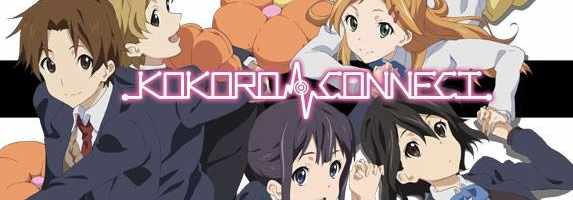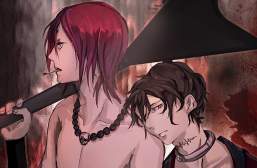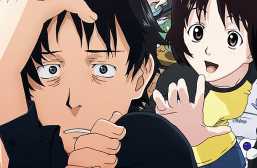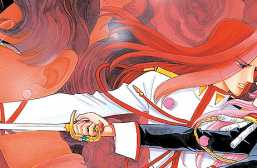Kokoro Connect (2012) Review: Freaky Friday Just Got a Lot Longer

There have been a number of movies over the last decade that have included the body-swapping plot element. Who hasn’t seen Lindsay Lohan’s Freaky Friday (2003) at least once? And body swapping took a different turn with It’s a Boy Girl Thing (2006), where the two main characters swapped genders. It’s a simple premise that opens doors to many forms of entertainment. Who hasn’t wanted to know what life was like in someone else’s shoes? Kokoro Connect (literally: “Hearts Connect) takes five close friends and introduces a more erratic form of body swapping: it happens at random and no one knows when it will stop.
Kokoro Connect is a 2012 production by studio SilverLink and is based on the light novel by Sadanatsu Anda, which is still ongoing. Adapted for the screen by Fumihiko Shimo (Kanon, CLANNAD) it has 13 episodes, then a further 14-17 to wrap up the story. Each light novel represents a four episode “arc” of the anime and a different ‘phenomenon’ that the heroes try to live with. In 17 episodes four arcs are covered. They transition smoothly into each other although they vary in terms of mood and writing quality. The first and third arcs have the most character exploration, heaviest themes and humorous dialogue. The second and fourth arcs (episodes 6-9 and 14-17) are the weakest. Even though the phenomenons are interesting they are not the main focus of comedic entertainment. You might as well forget there’s magical elements involved because those episodes deal with the romance part of the series rather than comedy or drama. Compared to the rest of the series it comes across as generic and flat.
Kokoro Connect is not a science fiction show. Like the drama Rumbling Hearts (2003), Kokoro Connect plays out like a soap opera. Yet it has everything a good soap should: interesting characters, a snappy premise, decent pacing, not too many love triangles… oh, and the anime ends. Since it is more about the characters and less about plot, it has a fair share of touching, addictive and comedic moments. It doesn’t take itself seriously so neither should you. It is a fun, simple and sweet story of facing adversity, overcoming fear and the joys of close friends. It is what K-ON would be if it actually had a story. Oh, snap.
Kokoro Connect is as silly as The Change Up (2011) with its premise so there’s no point trying to pretend it’s pancakes with nutella because it isn’t. As enjoyable and laid back KC is to watch, the most flawed story point is the questionable motives of the villain Heartseed, who was unfortunately named Balloon Vine in Japanese. If you are a creature who can manipulate the lives of people for giggles, why would you pick an angsty group of high school students? The only explanation I can think of without the light novel as a reference is perhaps Heartseed has had his fun with more influential people and is now scrapping the bottom of the barrel. Aside from Heartseed, the first half of episode one may be the hardest hurdle to jump over. As early as thirty seconds in (yes, I looked) the arc one gimmick is revealed and it takes some time for the characters to catch up. It was an intense mental exercise trying to figure out who is whom since everyone is switching bodies and they’ve exchanged a minute of dialogue together. It is a very jarring introduction to the body swap premise which doesn’t give much sympathy for the characters. While in Freaky Friday we get an idea of what Anna and Doctor Coleman’s life is like before the switch, it is a lot easier to see the contrast. Here it is the reverse. Thankfully from episode two the characters start to become more than pretty faces and the lame, confusing factor disappears fairly quickly.
The animation, like most television series varies in quality. The character designs by Yukiko Horiguchi (K-ON!) are consistent and pleasant throughout. They are drawn with medium sized eyes, small, pudgy faces and cute facial expressions. The soft colours, detailed backgrounds and fluid, range of movement is strongest in some of the opening and ending sequences, but the occasional high quality moment in the show. The ending credits especially explore metaphor and different drawing styles like coloring pencils or gradients. The animation isn’t nearly as smooth and 3D looking as K-ON, but it is still decent for a series of its type.
The soundtrack by Yasuhiro Misawa (Love Lab) is surprisingly good for a romantic comedy anime. Usually comedy anime suffer from horrible BGM with mostly synthesized, MIDI sounding junk (Chobits). Kokoro Connect has real instruments for its background music and is very similar to Welcome to the NHK! in this sense. Guitars, pianos, harmonicas and friends sufficiently add an atmosphere to scenes when needed. KC does a Mawaru Penguindrum (2011) with its multiple opening and ending songs. Considering how short it is it is surprising to see four ending songs and two openings. The most disappointing and average track is “Paradigm” by Eufonius. The second opening is a lot stronger vocally and the ending songs have catchier melodies than the openings. The english dub is decent. I am not usually a fan of Greg Ayres. In both Welcome to the NHK (2009) and CLANNAD (2007) his voice tends to crack and sound shrill when he yells. It seems like this was toned down a lot here, which worked a lot better. Some lines are delivered awkwardly but it is hardly noticeable. All the other voices fit the characters, were not overly squeaky and had believable acting.
The characters are what make the show, and it can make or break the experience for you. We are given a lot of detail to the characters pasts, more in conversation than flashbacks. In some instances this dampens the power of the scene. Like Yuri Nakamura’s back story in Angel Beats (2010), the scenes could have done with a couple of seconds of cut-away. However, it also down-to-earth too and resembles a mockumentary style than fiction. What KC does that many other body-swap or “Weird things are happening to me” films don’t, is explore the psychological effects of dealing with these new experiences. Anna from Freaky Friday may just comically cry “I want to go back to my body and my friends”, but it doesn’t expand beyond that. Despite having more empathy for her mother, Anna is the same person she started with at the beginning of the movie. In Kokoro Connect the different phenomena flip the characters inside out and bring all their character flaws to the surface, for better or worse.
This next section contains spoilers. For example, the pretty Yui Kiriyama comes across as polite, ladylike and even courageous but experiences an overwhelming anxiety when she is suddenly confined to the body of one of her worst fears: men. In episode 3, Yui’s anxiety is apparently so bad that Aoki notices it while he is in her body. He can’t shake his curiosity. In order to function Yui is pushed to discuss experiences she’s suppressed up until this point by the ever-persistent Taichi. Of course, if the show was being realistic it would be most effective for her to see a therapist but with KC a decent D&M is what does the trick. With the understanding and support of Taichi, Yui starts to accept her situation, and she takes baby steps in the third arc, particularly episode twelve to try desensitize herself tothe anxiety. In episode 6, Yui also discovers that she has a lot of pent-up anger and anorexic tendencies, something I have never heard mentioned in anime. There is an episode of Kaleido Star (2003) where a character starves herself, but it is not out of anxiety.
Iori Nagase is the second character which is debatably the most strongly affected by the phenomena and is commonly called the most realistic character in the show on forums. Although this is revealed in episode four, Iori is also incredibly self-aware. She fits an anxious, people-pleasing personality from her unstable, inconsistent and traumatic home experiences. Instead of withdrawing (like Yui) or rebelling, she is able to adapt to her circumstances and morph into whatever person she wants to get the best response out of those she cares about. For someone who, like many teenagers, is confused about who she is, it is brought to a whole other level when her friends minds, bodies or feelings are exposed and shared among one another. As early as episode two Iori asks Taichi in a philosophical discussion: what defines a person, if your personality is not unique anymore? Seeing parts of yourself in the characters make KC all the more enjoyable, and sets itself apart from other media with similar ideas.
Not all the characters were fleshed out to the same degree. The down-to-earth, blunt, fan-favorite Inaba Himeko has a different form of people pleasing going on. She fits into a strange personality type where she half feels the need to have drama in her life to feel unique and attract attention, even though she doesn’t have many problems and is a very confident person. On the other hand, she keeps her ideals to herself to keep her friendship group in one piece. It seems to be a sign of insecurity about her own confidence or a desperate want to belong. Do people need to have problems to develop strong bonds of friendship? It isn’t quite clear what Inaba’s issues are, but it’s very possible that she has as little idea as we do, which is realistic in its own right.
The boys are fleshed out the least. In episode three there is a foreboding sense that Taichi Yaegashi has a dark secret or there is some experience that inspired him to be a “selfless freak” in Inaba’s words or “altruistic”, but it isn’t explored much beyond the incessant questioning by Inaba. Is it really just about enduring pain and having resiliance like this favorite wrestlers? It seems like a superficial rather than the underlying reason. This is disappointing because they could have made Taichi incredibly interesting. Perhaps he was treated badly or treated others badly and decided that he didn’t want to hurt anyone? At least this character trait is addressed and questioned, unlike many leads in harem anime, where they would more realistically take advantage of all the characters like in School Days (2007). For a very long time it seemed like Aoki Yoshifumi would be the useless side character that everyone forgot about, however, he gets his time to shine eventually. It isn’t until episode eleven where we get any insight into his life, when he remembers a girl he used to have a crush on whom reminds him of Yui. It’s an interesting and incredibly nostalgic process to watch Aoki struggle to remember his past and look back on how his past relationship progressed the way it did. While his family situation is still left in the dark it was refreshing to see a teenager explore the idea of love on a philosophical level, as it is not to this extent in other anime. Knowing that the light novels have not finished yet gives a ray of hope that it may be answered at some point.
Considering the anime was based on a much longer work where the writing varies in uniqueness and quality, it would have been interesting to see what would happen if the most popular volumes of the light novels were brought to the screen. The last arcs purpose is to resolve the love triangle between the characters and finish fleshing out Iori’s arc. Despite these important resolutions it made little difference if the phenomenon was there at all as the material is closer to slice of life than fantasy. All that aside, KC doesn’t have any obvious filler and moves along at a steady pace. Many anime take place in high school, but Kokoro Connect explores ideas of self discovery, exploring sexuality and motivation which has not been done before. It balances comedy, down-to-earth drama, empathetic characters and a touch of wackiness in a modern-day setting which set it apart from other fantastic, more extreme representations of the mental states of adolescence like Neon Genesis Evangelion (1995). Kokoro Connect is one of those rare anime that I can envision being received positively among non-anime fans, particularly those who enjoy their evening soap opera. Any fanservice is done in context to the story and doesn’t feel out-of-place, and Heartseed is a straightforward, apparently simple-minded enough of a villain that he fits perfectly up against US Cartoon standards. It is simple enough to watch and enjoy with friends but interesting enough to keep wanting more, as it explores the consequences of “body swapping” and other similar phenomena in a more psychological level than films done before.
Rating:
What do you think? Leave a comment.











When i finished to watch this anime i said to myself in the end: “DAMN THAT WAS GOOD!” It was really strong dramatic a bit romantic and very very intresting(specialy the develop of the bond bitween the five).
I haven’t seen this anime yet but read the wiki and damn it seems like all the characters have feeling for each other like an damn hexigon love triangle.
Thanks i had Kokoro on my list of anime my friend emailed me to watch and now i might watch it after i’m done with Ano Natsu de Matteru(Im on ep 10 now) so thanks for giving me something to look forward too.
Haven’t watched this anime, but I avoided it cause of the whole slice of life genre. There’s an anime I’m watching called Total eclipse, first two episodes are awesome the rest are just okay though.
I have to say, there are no anime that I have watched like kokoro connect. It’s such a emotional, powerful anime, I always find my self laughing, crying, smiling, depressed during the anime. And is so easy to fit yourself into the characters too.
I’m not sure if it’s because the idea sounds so refreshing at first that I find the first arc the most interesting of all. Later arcs are good, but not quite as compelling as the first one. Still, I really enjoyed watching the series.
Agreed.
I think a strong point of the anime was the music, made all of the scenes more emotional.
Nice review. The story line so far is great, and the animation is beautiful.
I loved this anime, to bad there probably won’t be a season 2 after the prank the studio pulled on that poor actor. Inaban is best girl.
I LOOOOOOOOOOOOVVVVVVVVVVVVEEEEEEEEEEEEEE This ANIME!!!!
“[Kokoro Connect] is what K-ON would be if it actually had a story.” I don’t know the plots of either in any way other than cursory, and I don’t care about the old flame wars about this, but it does sound like some K-ON resentment.